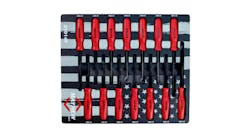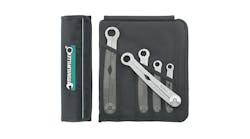Content brought to you by Motor Age. To subscribe, click here.
What You Will Learn:
• Maintenance can maximize return on investment
• There are three different types of maintenance, each with pros and cons
• Routine inspections/documentation can help to avoid breakdowns
Maintaining any machine or device is proven to help it provide a long and mostly issue-free life. And like many things in this day and age, maintenance itself has become more complicated. In this article we will discuss the different types of maintenance along with the best ways to monitor and document each vehicle for maximum return on investment and use.
There are three basic maintenance approaches that companies may take — each with pros and cons:
- Reactive maintenance (sometimes referred to as corrective maintenance)
- Preventive maintenance
- Predictive maintenance
Reactive maintenance
Reactive maintenance is basically waiting for the vehicle to actually break down before addressing any wear or issues. Hence why it is sometimes called corrective maintenance, since you only address the failed items. The hope is that the repairs will cost less than any maintenance that could have taken place. I’ve seen some fleets approach maintenance this way, retiring vehicles just before the original factory warranty expires.
The pros to reactive maintenance are that there are no costs or planning needed up front. Only when the item fails is when the cost and process to restore it to working condition are put into place.
The cons of being reactive can include additional costs that result from the failure, such as towing, lost time, or additional damage that can result from the failure.
Preventive maintenance
The next level of maintenance is preventive. The idea here is that regularly scheduled checks and maintenance are performed in the hope of avoiding down time for the vehicle.
Preventive maintenance pros are that the vehicle has scheduled downtime that can be worked around for minimal interruption of its use. Failure costs are reduced due to catching developing issues before they damage other systems and parts. Because service and checks are scheduled along with previous wear data being available, this helps enable the vehicle to operate as best as it can for a long time.
Cons to preventative maintenance include the need to adhere to monitoring vehicle operations and a set schedule which can be overbearing for the shop if many vehicles are involved. These schedules need to be based on a number of methods for determining when a vehicle needs to return. These methods are time, use, and vehicle condition. Combining these three for best results can be difficult and complicated.
Additionally, preventive maintenance cannot eliminate all possible vehicle breakdowns, though it will lower the number of them. So, in a way, reactive maintenance is a part of any preventive maintenance plan.
Predictive maintenance
The next level of maintenance is predictive. The idea here is to gather as much information as possible to predict when the vehicle is going to need service or repair. The information used can include live data from vehicles, input from inspections, and recording of vehicle wear history for comparison. Parts requirements can also be known in advance, decreasing waiting times during service having been pre-ordered based on the data.
Pros of predictive maintenance are that it reduces the time required to maintain a vehicle, saving time out of service including time worked on, and reduces parts costs and availability issues. When used properly, predictive maintenance can greatly reduce loss due to breakdowns.
Some of the cons of predictive maintenance include the overall cost and complexity of the system, which can include artificial intelligence software, vehicle monitoring devices and even specialists that may be needed to interpret the data. In other words, many of these predictive systems would only benefit large fleet operations.
With this understanding of the three approaches to maintenance that can be used with fleets, we can put together a system that works for your shop and any fleets that you may service. The best part is that these same ideas can be applied to your individual customers in a similar manner, which results in them returning on a regular basis and helping you boost your bottom line and customer satisfaction at the same time.
Action plan
Though the intervals have extended further and further, the oil change is still the main service that gets done on vehicles. Drivers and fleets understand the importance of fresh oil in their vehicles. Even with the extended intervals, the oil change is still the most frequent service vehicles get done. So why not use this fact as a foundation for the vehicle’s other needs?
Using digital software that tracks a vehicle’s mileage and time on the road, in addition to knowing the OEM or oil type requirements, we can calculate the average miles driven per day and predict when we expect the next oil change to be due. The next appointment can be automatically added to the shop calendar when the reminder sticker is printed. At the same time, a recommendation is posted in the management system.
With the same printing step, the software sets up a text reminder that is sent automatically to the fleet manager or driver prompting them that the next service is coming due in a week. Plans can be made to get the service done with little or no effect on the vehicle’s availability.
An advanced scheduling option is also available to take advantage of the miles driven per day calculations. Other items that have recurring intervals for service can also be connected to the oil change. For example, if a vehicle is getting the yearly Pennsylvania Safety inspection done with the oil change, the next appointment and automatic text reminder for next year’s inspection will be set.
Digital inspections
Digital inspections can also be part of this simple form of predictive maintenance. Each time a vehicle is in for service, its condition should be documented in pictures, video, and text. The first time a vehicle is in, a baseline inspection should be performed. The idea here is to document the vehicle completely as it is. Each inspection that occurs after this inspection will refer to the baseline inspection, showing the amount of wear that has occurred since it was done. I call this documentation a “wear history.”
For example, by using pictures, video, and descriptions, the wear history will show tread depth of the tires decrease over time. It doesn’t matter if the tread depth is measured in 32nds of an inch or in millimeters; the measurements will decrease, counting down to “retirement” or when it’s time to replace the tires.
Based on the digital inspection pictures and measurements, the time of tire replacement can be predicted with a fair amount of accuracy. Being able to show this wear across inspections can also help prepare the fleet for the upcoming replacement.
Document everything
A wear history can apply to other items such as brakes and even oil leaks. During an inspection a seep can be documented. During each inspection afterward, the leak can be checked to see if it was getting worse, progressing to being wet and even dripping and requiring attention.
For the wear history to work in helping predict future vehicle needs, it needs to document everything, even newly installed brake pads, for example. Note that also documenting the vehicle condition whether it is good, fair, or bad can also help in limiting your shop’s liability since you can always refer back to previous inspections if a question arises.
Recording the life cycle of parts requires the customer or fleet to return to your shop for subsequent inspections. Returning customers have a higher level of trust in your shop and therefore are more likely to buy more.
Sending copies of the vehicle inspections to the fleet manager can also result in a predictive maintenance type behavior. Before sending a vehicle to your shop based on earlier recommendations and reminders, the manager can look over the previous inspections and determine, based on the wear history, that the tires will need to be replaced on the next visit. Knowing this, they can reach out to your shop in advance so you can get the proper tire type in stock if you don’t already have them — saving both your shop and the vehicle down time waiting on them to arrive the day of the service.
Following the same suggestions and steps mentioned above, this predictive type of maintenance can be applied to your regular customers with the same results. Get repeat customers with oil changes and other services based on their actual driving habits. With digital inspections, document their vehicle’s vital components during each visit, building a wear history that will help you use a predictive type of maintenance program to prepare them for needed future work.

